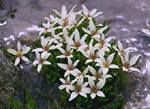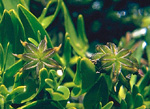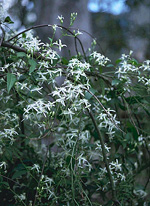 |
This family is most common in cool, moist habitats in temperate latitudes or at high elevations in warmer areas. In Australia, members of the family are most common in the highlands of the south-eastern mainland and Tasmania, in alpine and subalpine herbfields, marshes, moist forests and in grasslands. A few species occur in south-western Western Australia, while very few extend into the semi-arid region and to Central Australia.
Characteristic features of the family Ranunculaceae in Australia include: - herbs, or woody climbers with twining petioles (Clematis)
- leaves alternate or rosetted, usually compound or divided and with a basic 3-part division into leaflets
- flowers white, yellow or red, regular, with several free petals and sepals, or the petals absent and the sepals petal-like
- stamens usually numerous and spirally arranged, often slightly flattened
- ovary superior, usually of many free carpels tightly packed together into a globular or elongate mass in the centre of the flower
- fruit comprising a head of dry achenes (each developed from one carpel), sometimes each with a hairy awn (Clematis)
Description
Annual or perennial terrestrial herbs, or woody or herbaceous
vines climbing by scrambling or twining stems or petioles, or rarely aquatic
herbs rooted in the substrate with their leaves submerged, floating or
emergent, or rarely evergreen shrubs. Perennating by tubers, rhizomes,
stolons, taproots or crowns. Vegetative reproduction absent or by rhizomes,
tubers or stolons. Stem internodes solid or hollow. Internal secretions
not obvious. Plants glabrous or with simple, non-glandular hairs. Leaves
alternate and spiral, or opposite, or if herbs then the leaves cauline,
all or mostly basal, or both basal and cauline, petiolate. Stipules rarely
present, distinct and free from the petiole or fused, scale-like, or membranous,
or green and leafy, persistent; stipellae absent. Lamina simple, once
compound, bicompound or tricompound, ternate, palmate or imparipinnate,
symmetric, pinnatifid, pinnatisect, palmatifid, palmatisect, bipinnatifid
or tripinnatifid, etc; lamina/segments filiform, acicular, subulate, linear,
lanceolate, ovate, elliptic, oblanceolate, oblong, orbicular or reniform;
base cuneate, attenuate, rounded, cordate or lobed or auriculate; margins
entire, crenate, dentate or serrate, ±flat, revolute or recurved;
one-veined, or the venation pinnate or palmate, with the midrib conspicuous
or inconspicuous, and the tertiary venation not reticulate; surfaces not
punctate; herbaceous, leathery or succulent. All the flowers bisexual,
or rarely with male and female flowers occurring on separate plants. Inflorescences
terminal or axillary, consisting of racemes, panicles, dichasial cymes
or solitary flowers. Bracts and bracteoles present or absent. Pollination
by insects or wind, or rarely by water. Flowers odourless or fragrant,
stalked. Floral disc present or absent; nectaries absent or present on
the perianth or the carpels. Perianth of 2 dissimilar whorls, or all whorls
±similar, valvate or imbricate in bud. Calyx regular or rarely
irregular; segments free, with (4–) 5–8 sepals, herbaceous; base without
appendages, or rarely spurred. Corolla regular or rarely irregular; segments
free or fused, or rarely some fused and others free, with 0–5 (–20) petals
or lobes, alternating with or with no clear relationship to the sepals;
corolla funnel-shaped, 1-lipped, white, cream, yellow, red, pink, magenta,
purple or blue, or rarely green, without contrasting markings, membranous;
claws present or absent; lobes ±entire, or notched, emarginate,
bifid, bilobed, ciliate or fimbriate; base without appendages, or rarely
spurred. Fertile stamens (1–) 3–numerous, not clearly correlated with
the sepals, free of the corolla, free of the ovary and style, distinct
from each other, all ±equal. Staminodes present or absent. Anthers
basifixed, not versatile, opening outwards or sideways by longitudinal
slits, 2-celled; appendages absent or apical. Ovary superior and sessile.
Carpels (1–) 100, free from each other or rarely fused. Style terminal,
single and unbranched or rarely branching from the base. Ovules 1–numerous
per carpel, stalked; placentation basal, apical or axile. Fruit a dry
dehiscent septicidal capsule, or a follicle, or an indehiscent achene;
the perianth on the maturing fruit deciduous. Disseminule macro-surface
featureless, rostrate or awned, or with straight hairs or spines; micro-surface
±smooth, tuberculate or reticulate, brown, grey or black, dull.
Seeds 1–numerous per fruit. Aril absent. Cotyledons 2. Embryo straight
or round or shapeless.
(Note: this description has been generated from the coded data compiled for the key. Any errors in the key data will be reflected in the descriptions.)
A treatment of the family Ranunculaceae has not yet been published in the Flora of Australia. It will appear in Volume 2.
Australian genera of Ranunculaceae (as recognised for the Flora of Australia)
† = some species native, others introduced
* = all species introduced
*Adonis
Anemone
*Batrachium
Caltha
†Clematis
*Consolida
*Ficaria
Myosurus
*Nigella
†Ranunculus

|
  |

Caltha introloba (flowering plant)
Photo: C.Totterdell © ANBG

Caltha introloba (fruits)
Photo: A.S.George © A.S.George

Clematis aristata (flowers)
Photo: D.Greig © ANBG

Clematis microphylla var. leptophylla (flowers)
Photo: M.Fagg © ANBG

|
 |
|